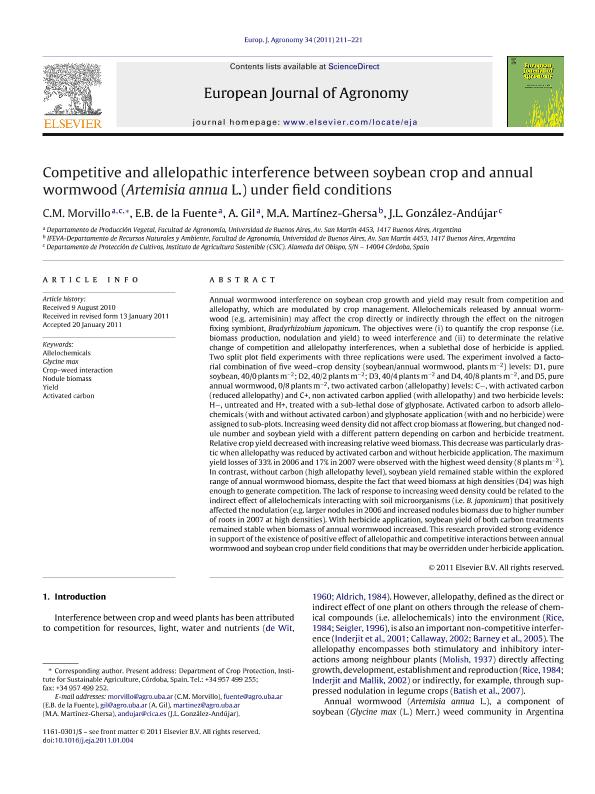Artículo
Competitive and allelopathic interference between soybean crop and annual wormwood (Artemisia annua L.) under field conditions
Morvillo, Claudia Mariela; de la Fuente, Elba Beatriz; Gil, Alejandra; Martinez-Ghersa, Maria Alejandra ; González Andújar, J. L.
; González Andújar, J. L.
 ; González Andújar, J. L.
; González Andújar, J. L.
Fecha de publicación:
05/2011
Editorial:
Elsevier Science
Revista:
European Journal of Agronomy
ISSN:
1161-0301
Idioma:
Inglés
Tipo de recurso:
Artículo publicado
Clasificación temática:
Resumen
Annual wormwood interference on soybean crop growth and yield may result from competition and allelopathy, which are modulated by crop management. Allelochemicals released by annual wormwood (e.g. artemisinin) may affect the crop directly or indirectly through the effect on the nitrogen fixing symbiont, Bradyrhizobium japonicum. The objectives were (i) to quantify the crop response (i.e. biomass production, nodulation and yield) to weed interference and (ii) to determinate the relative change of competition and allelopathy interferences, when a sublethal dose of herbicide is applied. Two split plot field experiments with three replications were used. The experiment involved a factorial combination of five weed-crop density (soybean/annual wormwood, plantsm-2) levels: D1, pure soybean, 40/0plantsm-2; D2, 40/2plantsm-2; D3, 40/4plantsm-2 and D4, 40/8plantsm-2, and D5, pure annual wormwood, 0/8plantsm-2, two activated carbon (allelopathy) levels: C-, with activated carbon (reduced allelopathy) and C+, non activated carbon applied (with allelopathy) and two herbicide levels: H-, untreated and H+, treated with a sub-lethal dose of glyphosate. Activated carbon to adsorb allelochemicals (with and without activated carbon) and glyphosate application (with and no herbicide) were assigned to sub-plots. Increasing weed density did not affect crop biomass at flowering, but changed nodule number and soybean yield with a different pattern depending on carbon and herbicide treatment. Relative crop yield decreased with increasing relative weed biomass. This decrease was particularly drastic when allelopathy was reduced by activated carbon and without herbicide application. The maximum yield losses of 33% in 2006 and 17% in 2007 were observed with the highest weed density (8plantsm-2). In contrast, without carbon (high allelopathy level), soybean yield remained stable within the explored range of annual wormwood biomass, despite the fact that weed biomass at high densities (D4) was high enough to generate competition. The lack of response to increasing weed density could be related to the indirect effect of allelochemicals interacting with soil microorganisms (i.e. B. japonicum) that positively affected the nodulation (e.g. larger nodules in 2006 and increased nodules biomass due to higher number of roots in 2007 at high densities). With herbicide application, soybean yield of both carbon treatments remained stable when biomass of annual wormwood increased. This research provided strong evidence in support of the existence of positive effect of allelopathic and competitive interactions between annual wormwood and soybean crop under field conditions that may be overridden under herbicide application. © 2011 Elsevier B.V.
Archivos asociados
Licencia
Identificadores
Colecciones
Articulos(IFEVA)
Articulos de INST.D/INV.FISIOLOGICAS Y ECO.VINCULADAS A L/AGRIC
Articulos de INST.D/INV.FISIOLOGICAS Y ECO.VINCULADAS A L/AGRIC
Citación
Morvillo, Claudia Mariela; de la Fuente, Elba Beatriz; Gil, Alejandra; Martinez-Ghersa, Maria Alejandra; González Andújar, J. L.; Competitive and allelopathic interference between soybean crop and annual wormwood (Artemisia annua L.) under field conditions; Elsevier Science; European Journal of Agronomy; 34; 4; 5-2011; 211-221
Compartir
Altmétricas



